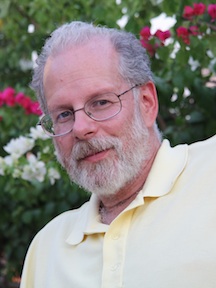By Caitlin Clay
The Phi Beta Kappa Chapter at the University of Dallas in Irving, Texas, recently had the privilege of hosting Phi Beta Kappa Visiting Scholar Larry A. Silver, the Farquhar Professor of Art History at the University of Pennsylvania and a specialist in Northern European paintings and graphics during the Renaissance and Reformation eras. Silver’s lecture, “Marked and Modern Jewish Artists: Marc Chagall, Ben Shahn, and Mark Rothko,” was given as part of the recent opening of the Marc Chagall: Intersecting Traditions art exhibition at the University of Dallas. The exhibition features more than 50 original works from a series of 105 hand water colored etchings depicting scenes from the Old Testament. Before the lecture, I had the opportunity to walk through the exhibition with Silver and discuss the importance of Chagall’s art.
A Jewish, Russian-French artist who lived from 1887 till 1985, Chagall had a long and prolific career. He grew up in the city of Vitebsk in Belarus, which was under Russian control at that time. Chagall is notable not only for the abundant amount of work he produced, but also because his artwork cannot be categorized into any particular art movement. Silver told me that this commissioned set of etchings, known as the Bible Series (1931-1956), took Chagall nearly 25 years to complete. Silver also noted that by this time in his career, Chagall was very interested in combining Judeo-Christian symbols in order to encourage peace and understanding between religions, as well as link important Jewish narratives with symbols of Christian salvation.
Chagall depicted Old Testament figures in a folk art manner, and he used color to highlight important characters and objects, or to suggest a character’s emotions. Moses and King David, two famous Old Testament figures, are represented in multiple prints, due not only to their importance as Jewish religious and political leaders, but also to the numerous biblical stories of their trials and tribulations. Chagall desired to portray the human aspects of two religious prophets who are often only celebrated for their devoutness.
By portraying biblical heroes and stories in an inventive and energetic way, Chagall seemed to hope the viewer would undergo an intense spiritual experience when encountering his art. In Silver’s lecture, he linked Chagall’s wish for the viewer to understand the human side of the divine biblical stories with Rothko’s aspirations to create artwork that would inspire spiritual and human transcendence.
Rothko was a Jewish-American painter who was born in Dvinsk, an area also under the Russian control. He lived from 1903 till 1970, and he is identified by his unique abstract expressionist color field paintings. Rothko believed he portrayed basic human emotions, such as ecstasy, anger, and sadness, through his use of color and blurred shapes. Viewers are meant to experience spiritual transcendence when confronted by his large, multi-colored paintings. Silver remarked in his lecture that Rothko, unlike Chagall, never seemed to embrace his Jewish heritage. Rather than use Judeo-Christian symbolism, Rothko used abstraction and color to invite his viewers to experience the spiritually sublime.
The third artist Silver spoke on was Shahn, a Jewish, Lithuanian-born American artist who lived from 1898 till 1969. He is best known for his works of social realism and political activism. Much of Shahn’s art focuses on promoting justice for the American people. Several of his works took the form of large-scale murals, such as the Roosevelt Mural. Shahn outwardly denied his Jewish heritage, but according to Silver, his work shows a Jewish artist who is sensitive to the struggles of Jewish-American immigrants.
In his lecture, Silver reasoned that all three artists–Chagall, Rothko, and Shahn–were “marked” by their Jewish ancestry. Their origins influenced their art-making to such a degree that it is nearly impossible to appreciate their work without understanding the artists’ religious backgrounds. Despite their different styles, Chagall, Rothko, and Shahn were all concerned with illustrating the human aspects of religion, society, and culture. They all believed that their art would bring to mind a peaceful and spiritual future for humanity.
Larry A. Silver gave his lecture on February 8, 2016, at the University of Dallas in Irving, Texas.
Caitlin Clay is a senior at the University of Dallas majoring in Art History. She is most interested in studying and researching Modern and Contemporary Art. The University of Dallas is home to the Eta of Texas Chapter of Phi Beta Kappa.




